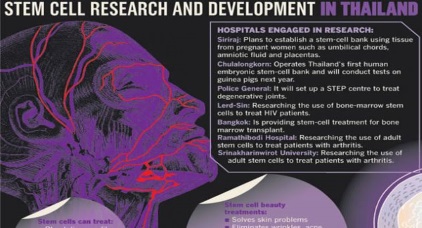Thailand is fascinated with “roadmaps”, but when it comes to life-or-death matters like regenerative science, the country has none.
Thai successes in stem-cell research have come despite a lack of funding or a national plan
Thailand is fascinated with “roadmaps”, but when it comes to life-or-death matters like regenerative science, the country has none.
Shinya Yamanaka and John Gurdon cheered regenerative scientists around the world, including those working on stem-cell body rebuilding in private and public hospitals here, when they were awarded the Nobel Prize for Physiology or Medicine on October 8.
But looking back at the environment at home, Thai scientists sighed. Local development of the technique has been direction-less and under-funded.
Stem-cell research has drawn attention from scientists around the world, including Thai scientists, ever since South Korea’s Dr Hwang Woo-suk and his team reported that they had successfully created human embryonic stem cells by cloning in 2005.
Even though much of this “breakthrough” research was later found to have been faked, many researchers and scientists in Thailand continued to follow their curiosity to discover how to effectively use stem cells for treatment.
Over the past decade, stem cell-related research centres have mushroomed at public and private educational institutions and hospitals across the country, such as centres for heart disease, diabetes, Alzheimer’s disease, Parkinson’s disease, thalassemia and leukaemia.
Already this year, at least three universities have reported success in stem-cell research.
Chulalongkorn University early this year proclaimed that it was the first in Thailand to produce human embryonic stem cells and established the country’s first embryonic stem-cell bank.
Police General Hospital has developed adult stem cells to treat arthritis sufferers. The hospital is now conducting a clinical trial on 60 arthritis patients aged 45-60. The human trial is expected to be completed next year.
Last week, a team of researchers at Mahidol University’s Siriraj Hospital said they had discovered a method to extract pure stem cells from human amniotic fluid, which they say could be potentially used to treat several severe conditions such as arthritis.
But looking behind their success stories, we can see that most of them had to rely on their own funds to establish their laboratories and conduct studies. Only a portion of the money came from the government.
“The government has never paid attention to supporting scientific research. We had to use our own funds collected from donations to do stem-cell research and conduct studies,” Lt-General Jongjet Aojanepong, director of Police General Hospital, said recently.
The hospital has spent about Bt3 million-Bt4 million to conduct stem-cell research on arthritis patients. The hospital also wants to conduct another study on how stem cells can restore severely damaged neurons next year, but still lacks a budget to carry on.
Researchers need not only funding but also a national roadmap to steer stem-cell research and development.
Stem-cell therapy will be a key treatment in the near future. We need a formal forum to see the future together,” he said
Stem-cell research is booming in Thailand, but there is no central organisation to systematically manage the research budget and chart the direction of stem cell research.
Even though the government has set up the National Research Council of Thailand (NRCT) to oversee all research in the country, most of the budget was allocated to support research on agriculture, which is a priority need for the country.
The council gets about Bt10 billion from the government to support all research in the country, but only Bt60 million-Bt100 million per year goes to stem-cell research, said Dr Soottiporn Chittrmittrapap, secretary-general of the NRCT.
“I think the number of people who might benefit from stem cell research is only in the hundreds – [less than] in other fields,” he said.
However, he agreed with Jongjet’s idea of drafting a national roadmap so that Thailand can have a clear direction for researchers and scientists to conduct research.
The roadmap should focus on diseases that remain difficult to treat such as macular degeneration, which is the leading cause of blindness.
“We will come up with the stem-cell research roadmap by the end of this year, as we plan to organise a conference and invite all stem-cell experts to give their opinion on this roadmap,” he said.
In Thailand, there are at least four main agencies supporting stem-cell research – the NRCT; the Thailand Research Fund; the National Science and Technology Development Agency; and the Public Health Ministry. But these agencies work separately on stem-cell research.
To draw up the national stem-cell research roadmap, Dr Chatree Duangnet, vice president of Bangkok Dusit Medical Services (BGH), said educational institutions should be a key player in brainstorming ideas with stakeholders to designate the country’s goals, strategy, direction and financial support for stem-cell research.
“The government should speed up its work to come up with a national roadmap and policy for stem-cell research to support Thai scientists and researchers, as this kind of therapy will be the next generation of medical treatment,” he said.
Bangkok Hospital, run by BGH, has conducted stem-cell research in the treatment of heart disease, but had to stop after the Medical Council issued a regulation forbidding private hospitals from conducting such research.
The hospital has been limited to joining with foreign medical institutions, such as the University of Texas MD Anderson Centre, by supporting financial sources in the study of bone-marrow transplants.
“Stem cells will play an important role in treatment and estimate the risk of medicinefor patients in 10 years. So the stem-cell research roadmap would help us to see which way we should go,” Soottiporn added.


